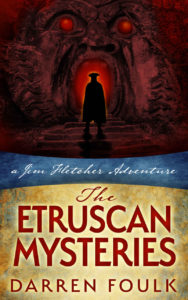 Title: The Etruscan Mysteries
Title: The Etruscan Mysteries
Author: Darren Foulk
Designer: Alexandra Brandt
Genre: Adventure, fantasy
Graphics: This appears to be the first book of an intended series. It takes place in the eighteenth century and, according to the book description at Amazon, is partly a travelogue, partly a historical novel, and includes elements of fantasy and even horror. The author seems to have combined multiple genres. The cover illustration suggests at least some of them.
The upper half of the cover is in deep red tones. It shows the silhouette of a man in a cape, presumably the protagonist. He is standing partway up steps that lead to an Indiana Jones-style gaping mouth carved into what might be the entrance to a cave. The mouth is aglow, and above the entrance are flaring nostrils and equally glowing eyes.
The spookiness factor is clear, but the image itself is muddy. Of the three partitions of the cover—image, series frame, and title and author frame—the image is the part that stands out least, even though it is largest. That’s because it’s too dark.
One understands the designer’s desire to maximize tension, but it has come at the expense of giving the image its proper due. The cave is so dark that the silhouette doesn’t stand out sufficiently, even the part of it in front of the glowing mouth.
I would lighten all the elements of the image, other than the silhouette, which of course should remain black. The image would retain an impression of darkness without actually being dark. By being lighter, it would show off its details better, particularly encrustations on the rocky face that give the rock the appearance of a face. At the current small size it’s hard to tell, but the rock actually shows cheeks. They would show up better if the image were lighter.
Typography: The title and author name are in the same font, with the exception of “The.” The text is easily read, but the letters are not well kerned. This is more obvious in the title than in the author name, which has wide kerning.
There are few pairs of letters in the title with equal spacing, or so it seems. Look at the final E and S: they actually touch one another. There is more space between the I and the E than between the R and the I. On the top line, the E-T combination is tighter than the T-R combination. Similarly for the C-A and A-N combinations.
The author name doesn’t line up squarely under the title. It’s a little too wide. It’s also a little too close to the bottom. On the other hand, the first word of the title, “The,” appears in the font used for the series information. That’s fine, but it seems cramped, lying too close to the blue partition.
These problems could be resolved if the title were reduced in height by about a third. It’s larger than it needs to be for legibility, and a reduction in its size would help focus attention on the image. Once the title is made smaller, its letters would have more room to stretch out and breathe, and the author name and “The” could be spaced further from their respective edges.
The series information, which appears in the blue area, is illegible at thumbnail size. The font looks as though it belongs to the eighteenth century, which is good, but it is hard to read, which is not good. Perhaps it could be compressed horizontally so that its size could be boosted a few points.
To achieve that happily, it might be necessary to enlarge the blue area, which could be done at the expense of the area below if the title were made more compact.
Overall: This cover is not far from being first-rate. Each element is fine in substance, but each needs work. This is true especially of the image, which ought to be the focal point of the cover but isn’t, partly because of its dull tones but partly because of the too-large title, which draws attention away from the image.
